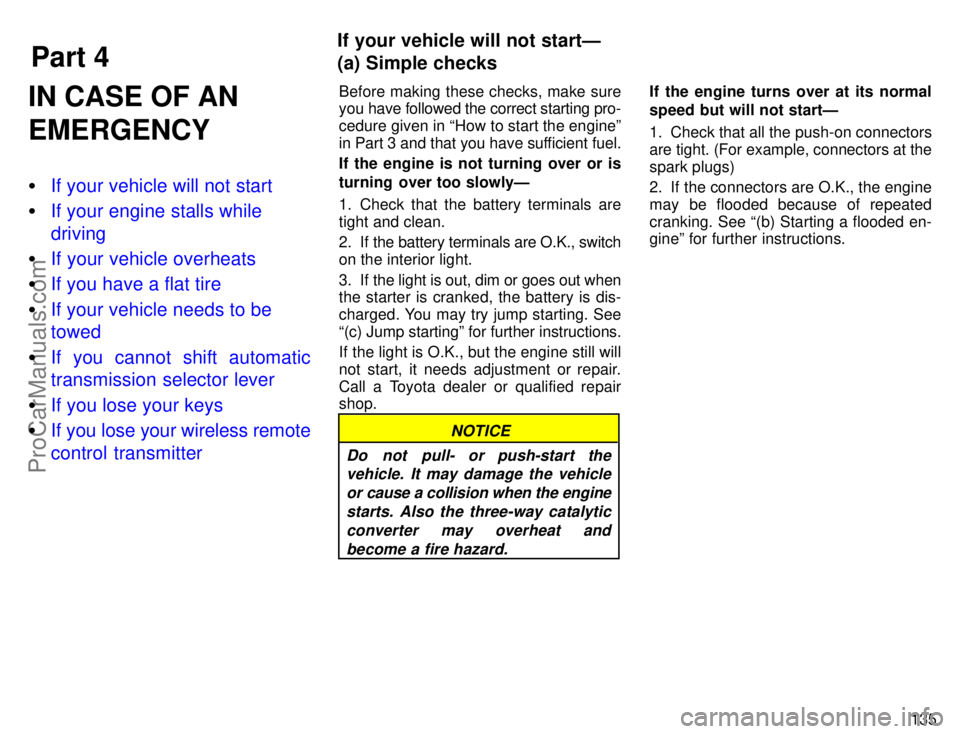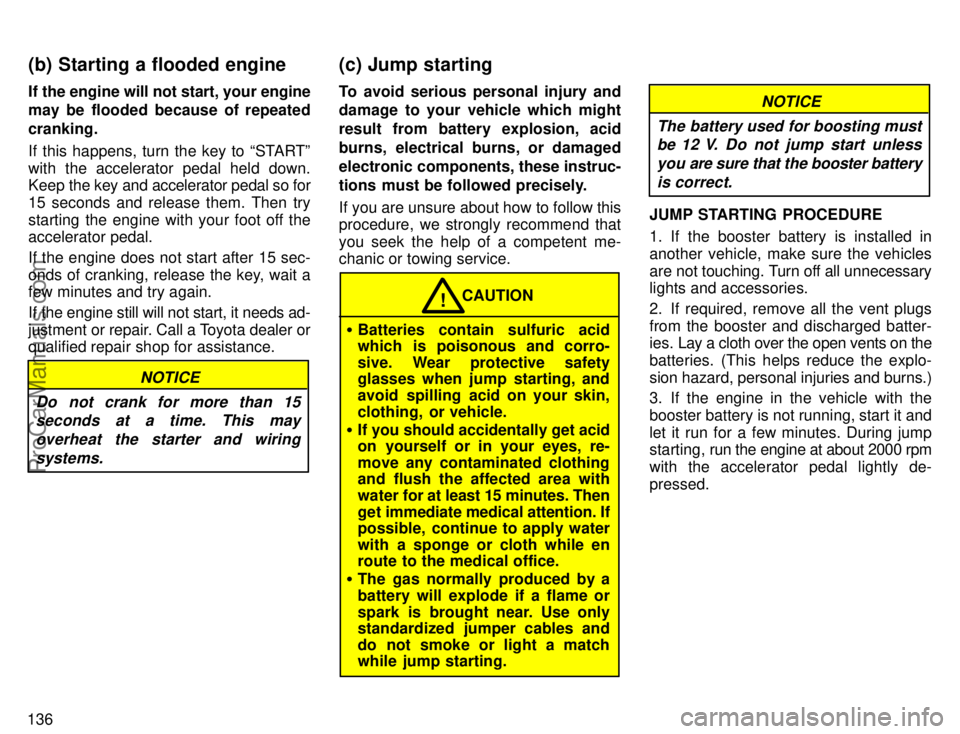Page 136 of 202

Part 4
135
IN CASE OF AN
EMERGENCY
�If your vehicle will not start
� If your engine stalls while
driving
� If your vehicle overheats
� If you have a flat tire
� If your vehicle needs to be
towed
� If you cannot shift automatic
transmission selector lever
� If you lose your keys
� If you lose your wireless remote
control transmitter
Before making these checks, make sure
you have followed the correct starting pro-
cedure given in How to start the engineº
in Part 3 and that you have sufficient fuel.
If the engine is not turning over or is
turning over too slowlyÐ
1. Check that the battery terminals are
tight and clean.
2. If the battery terminals are O.K., switch
on the interior light.
3. If the light is out, dim or goes out when
the starter is cranked, the battery is dis-
charged. You may try jump starting. See
(c) Jump startingº for further instructions.
If the light is O.K., but the engine still will
not start, it needs adjustment or repair.
Call a Toyota dealer or qualified repair
shop.
NOTICE
Do not pull- or push-start the vehicle. It may damage the vehicle
or cause a collision when the enginestarts. Also the three-way catalyticconverter may overheat andbecome a fire hazard.
If the engine turns over at its normal
speed but will not startÐ
1. Check that all the push-on connectors
are tight. (For example, connectors at the
spark plugs)
2. If the connectors are O.K., the engine
may be flooded because of repeated
cranking. See (b) Starting a flooded en-
gineº for further instructions.
If your vehicle will not startÐ
(a) Simple checks
ProCarManuals.com
Page 137 of 202

136If the engine will not start, your engine
may be flooded because of repeated
cranking.
If this happens, turn the key to STARTº
with the accelerator pedal held down.
Keep
the key and accelerator pedal so for
15 seconds and release them. Then try
starting the engine with your foot off the
accelerator pedal.
If the engine does not start after 15 sec-
onds of cranking, release the key, wait a
few minutes and try again.
If the engine still will not start, it needs ad-
justment or repair. Call a Toyota dealer or
qualified repair shop for assistance.
NOTICE
Do not crank for more than 15 seconds at a time. This may
overheat the starter and wiringsystems.
To avoid serious personal injury and
damage to your vehicle which might
result from battery explosion, acid
burns, electrical burns, or damaged
electronic components, these instruc-
tions must be followed precisely.
If you are unsure about how to follow this
procedure, we strongly recommend that
you seek the help of a competent me-
chanic or towing service.
� Batteries contain sulfuric acid
which is poisonous and corro-
sive. Wear protective safety
glasses when jump starting, and
avoid spilling acid on your skin,
clothing, or vehicle.
� If you should accidentally get acid
on yourself or in your eyes, re-
move any contaminated clothing
and flush the affected area with
water for at least 15 minutes. Then
get immediate medical attention. If
possible, continue to apply water
with a sponge or cloth while en
route to the medical office.
� The gas normally produced by a
battery will explode if a flame or
spark is brought near. Use only
standardized jumper cables and
do not smoke or light a match
while jump starting. CAUTION
!
NOTICE
The battery used for boosting must be 12 V. Do not jump start unless
you are sure that the booster batteryis correct.
JUMP STARTING PROCEDURE
1. If the booster battery is installed in
another vehicle, make sure the vehicles
are not touching. Turn off all unnecessary
lights and accessories.
2. If required, remove all the vent plugs
from the booster and discharged batter-
ies. Lay a cloth over the open vents on the
batteries. (This helps reduce the explo-
sion hazard, personal injuries and burns.)
3. If the engine in the vehicle with the
booster battery is not running, start it and
let it run for a few minutes. During jump
starting, run the engine at about 2000 rpm
with the accelerator pedal lightly de-
pressed.
(b) Starting a flooded engine (c) Jump starting
ProCarManuals.com
Page 139 of 202

1385. Start your engine in the normal way.
After starting, run it at about 2000 rpm for
several minutes with the accelerator ped-
al lightly depressed.
6. Carefully disconnect the cables in the
exact reverse order: the negative cable
and then the positive cable.
7. Carefully dispose of the battery cover
clothsÐthey may now contain sulfuric
acid.
8. If removed, replace all the battery vent
plugs.
If the cause of your battery discharging is
not apparent (for example, lights left on),
you should have it checked.
If your engine stalls while driving
0
1. Reduce your speed gradually, keeping
a straight line. Move cautiously off the
road to a safe place.
2. Turn on your emergency flashers.
3. Try starting the engine again.
If the engine will not start, see If your ve-
hicle will not startº.
If the engine is not running, the
power assist for the brakes and
steering will not work so steering
and braking will be much harder
than usual. CAUTION
!
If your engine coolant temperature
gauge indicates overheating, if you
experience a loss of power, or if you
hear a loud knocking or pinging noise,
the engine has probably overheated.
You should follow this procedure
0
1. Pull safely off the road, stop the vehicle
and turn on your emergency flashers. Put
the transmission in Pº and apply the park-
ing brake. Turn off the air conditioning if it
is being used.
2. If coolant or steam is boiling out of the
radiator or reservoir, stop the engine. Wait
until the steam subsides before opening
the hood. If there is no coolant boiling over
or steam, leave the engine running and
make sure the electric cooling fan is oper-
ating. If it is not, turn the ignition off.
To help avoid personal injury, keep
the hood closed until there is no
steam. Escaping steam or coolant is
a sign of very high pressure. CAUTION
!
3. Look for obvious coolant leaks from
the radiator, hoses, and under the vehicle.
However, note that water draining from
the air conditioning is normal if it has been
used.
If your vehicle overheats
If your engine stalls while
driving
ProCarManuals.com
Page 202 of 202

Publication No. OM22481U
Part No. 01999-22481
Printed in Japan 09- 9901- 02
Quick index
�If a service reminder indicator or warning buzzer comes on 60 . . . . .
� If your vehicle will not start 135 . . . . . . . . . . . . . . . . . . . . . . . . . . . . . . . . . . .
� If your engine stalls while driving 138 . . . . . . . . . . . . . . . . . . . . . . . . . . . . . .
� If your vehicle overheats 138 . . . . . . . . . . . . . . . . . . . . . . . . . . . . . . . . . . . . .\
.
� If you have a flat tire 139 . . . . . . . . . . . . . . . . . . . . . . . . . . . . . . . . . . . . .\
. . . .
� If your vehicle needs to be towed 145 . . . . . . . . . . . . . . . . . . . . . . . . . . . . .
� Tips for driving during break- in period 113 . . . . . . . . . . . . . . . . . . . . . . . . .
� How to start the engine 125 . . . . . . . . . . . . . . . . . . . . . . . . . . . . . . . . . . . . .\
. .
� General maintenance 158 . . . . . . . . . . . . . . . . . . . . . . . . . . . . . . . . . . . . .\
. . . . .
� Complete index 197 . . . . . . . . . . . . . . . . . . . . . . . . . . . . . . . . . . . . .\
. . . . . . . . . .
Gas station information
Fuel type:
UNLEADED GASOLINE, Research Octane Number 91 (Octane Rating 87)
or higher. For improved vehicle performance, the use of premium unleaded
gasoline with a Research Octane Number of 96 (Octane Rating 91) or higher
is recommended.
See page 113 for detailed information.
Fuel tank capacity:
70 L (18.5 gal., 15.4 lmp. gal.)
Engine oil: API SH, Energy- Conserving IIº multigrade engine oil or ILSAC multigrade
engine oil is recommended.
See page 168 for detailed information.
Automatic transmission fluid: Automatic transmission fluid DEXRON
)-ll
Tire information: See pages 171 through 174.
Tire pressure: See page 192.
B
ProCarManuals.com